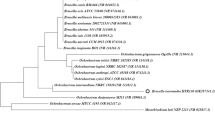Abstract
Stenotrophomonas sp. RMSK capable of degrading acenaphthylene as a sole source of carbon and energy was isolated from coal sample. Metabolites produced were analyzed and characterized by TLC, HPLC and mass spectrometry. Identification of naphthalene-1,8-dicarboxylic acid, 1-naphthoic acid, 1,2-dihydroxynaphthalene, salicylate and detection of key enzymes namely 1,2-dihydroxynaphthalene dioxygenase, salicylaldehyde dehydrogenase and catechol-1,2-dioxygenase in the cell free extract suggest that acenaphthylene metabolized via 1,2-dihydroxynaphthalene, salicylate and catechol. The terminal metabolite, catechol was then metabolized by catechol-1,2-dioxygenase to cis,cis-muconic acid, ultimately forming TCA cycle intermediates. Based on these studies, the proposed metabolic pathway in strain RMSK is, acenaphthylene → naphthalene-1,8-dicarboxylic acid → 1-naphthoic acid → 1,2-dihydroxynaphthalene → salicylic acid → catechol → cis,cis-muconic acid.




Similar content being viewed by others
References
Cerniglia CE (1992) Degradation of polycyclic aromatic hydrocarbons. Biodegradation 3:351–368
Chapman PJ (1979) Degradation mechanisms. In: Bourquin AW, Pritchard PH (eds) Proceedings of the workshop: microbial degradation of pollutants in marine environments. U.S. Environmental Protection Agency, Gulf Breeze, pp 28–66
Crawford RL, Hutton SW, Chapman PJ (1975) Purification and properties of gentisate1,2-dioxygenase from Moraxella osloensis. J Bacteriol 121:794–799
Feist CF, Hegeman GD (1969) Phenol and benzoate metabolism by Pseudomonas putida: regulation of tangential pathways. J Bacteriol 100:869–877
Garity GM, Bell JA, Lilburn TG (2004) Part-B: gammaproteobacteria. In: Brenner DJ, Krieg NR, Staley JT (eds) Bergey’s manual of systematic bacteriology, 2nd edn, vol 2: the proteobacteria. Springer, New York, pp 105–106
Hegeman GD (1966) Synthesis of the enzymes of the Mandelate pathway by Pseudomonas putida. J Bacteriol 91:1140–1154
Kim JS, Kim JH, Ryu EK, Kim JK, Kim CK, Hwang I, Lee K (2004) Versatile catabolic properties of the Tn4371-encoded bph pathway in Comamonas testosteroni (formerly Pseudomonas sp.) NCIMB 10643. J Microbiol Biotechnol 14:302–311
Komatsu T, Omori T, Kodama T (1993) Microbial degradation of polycyclic aromatic hydrocarbons acenaphthene and acenaphthylene by a pure bacterial culture. Biosci Biotech Biochem 57:864–865
Kuhm AE, Stolz A, Ngai KL, Knackmussi HJ (1991) Purification and characterization of a 1,2-dihydroxynaphthalene dioxygenase from a Bacterium that degrades naphthalenesulfonic acids. J Bacteriology 173:3795–3802
Lowry OH, Rosebrough NJ, Farr AL, Randall RJ (1951) Protein measurement with the Folin phenol reagent. J Biol Chem 193:265–275
Nayak AS, Vijaykumar MH, Karegoudar TB (2009) Characterization of biosurfactant produced by Pseudoxanthomonas sp. PNK-04 and its application in bioremediation. Int Biodeter Bioder 63:73–79
Phale PS, Mahajan MC, Vaidyyanathan CS (1995) A pathway for biodegradation of 1-naphthoic acid by Pseudomonas maltophilia CSV89. Arch Microbiol 163:42–47
Schocken MJ, Gibson DT (1984) Bacterial oxidation of the polycyclic aromatic hydrocarbons acenaphthene and acenaphthylene. Appl Environ Microbiol 48:10–16
Schocken MJ, Gibson DT (1996) Oxidation of naphthenoaromatic and methyl-substituted aromatic compounds by naphthalene-1,2-dioxygenase. Appl Environ Microbiol 62:507–514
Shamsuzzaman KM, Barnsley EA (1974) The regulation of naphthalene metabolism. Biochem Biophys Res Commun 60:582–589
Siriwat P, Kobchai P, Sarunya P, Thanyanuch K, Kanchana J, Suthep T, Amorn P, Pairoh P (2006) Novel intermediates of acenaphthylene degradation by Rhizobium sp. Strain CU-A1: evidence for naphthalene-1, 8-dicarboxylic acid metabolism. Appl Environ Microbiol 72:6034–6039
Tamura K, Dudley J, Nei M, Kumar S (2007) MEGA4: molecular evolutionary genetics analysis (MEGA) software version 4.0. Mol Biol Evol 24:1596–1599
Veeranagouda Y, Emanualpaul PV, Gorla P, Siddavattam D, Karegoudar TB (2006) Complete mineralization of dimethylforamide by Ochrobacterium sp. DGVK1 isolated from the soil sample collected from the coalmine leftovers. Appl Microbiol Biotechnol 71:369–375
Acknowledgments
We express our thanks to Central Drug Research Institute (CDRI) Lucknow, India for analysis of standards and acenaphthylene metabolites by LC–ESI–MS.
Author information
Authors and Affiliations
Corresponding author
Rights and permissions
About this article
Cite this article
Nayak, A.S., Veeranagouda, Y., Lee, K. et al. Metabolism of acenaphthylene via 1,2-dihydroxynaphthalene and catechol by Stenotrophomonas sp. RMSK. Biodegradation 20, 837–843 (2009). https://doi.org/10.1007/s10532-009-9271-1
Received:
Accepted:
Published:
Issue Date:
DOI: https://doi.org/10.1007/s10532-009-9271-1




